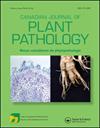Cover crop usage for the sustainable management of soilborne diseases in woody ornamental nursery production system
IF 1.5
4区 农林科学
Q3 PLANT SCIENCES
引用次数: 5
Abstract
Abstract Cover crops represent a potential tool for suppression of soil borne diseases in woody ornamental nursery production, which can cause significant economic losses. Field experiments were conducted in 2019 and 2020 to explore the effects of a cover crop and the timing of cover crop disturbance on soilborne disease suppression. Soils from red maple (Acer rubrum ‘October Glory’) plantations grown with or without a cover crop [crimson clover (Trifolium incarnatum)] were sampled following senescence of the cover crop. Greenhouse bioassays were conducted using red maple cuttings on inoculated (with Rhizoctonia solani, Phytopythium vexans or Phytophthora nicotianae) and non-inoculated field soils. Plant height, total and root fresh weight were measured, and the roots were assessed for disease severity on a 0 to 100% root damage scale. Pathogen recovery was assessed by culturing root pieces (~1 cm length) on oomycetes or Rhizoctonia semi-selective media. Soil samples were analyzed for organic matter, nitrogen, phosphorus, potassium, pH and Pseudomonad population count. A minimal effect of cover crop disturbance timing (late fall or early spring) was found on disease suppression. Cover crop usage reduced disease severity and pathogen recovery in red maple field soils. Plants grown in cover cropped soil had greater total, root and aboveground fresh weight compared with those from non-cover cropped soil, but plant height was not affected. Cover crops increased soil organic matter and total nitrogen in 2020. Pseudomonad populations were higher when cover crops were used. The results suggest that cover crops can reduce soilborne disease in woody ornamentals.覆盖作物利用对木本观赏苗木生产系统土传病害可持续管理的影响
摘要在木本观赏苗圃生产中,覆盖作物是抑制土传疾病的一种潜在工具,可能会造成重大经济损失。2019年和2020年进行了田间试验,以探索覆盖作物和覆盖作物干扰时间对抑制土传疾病的影响。在覆盖作物衰老后,对有或没有覆盖作物[红三叶草(Trifolium incarnatum)]生长的红枫(Acer rubrum‘October Glory’)种植园的土壤进行取样。使用红枫插条在接种的土壤(用立枯丝核菌、烟草疫霉菌或烟草疫霉菌)和未接种的田间土壤上进行温室生物测定。测量株高、总重量和根鲜重,并在0至100%根损伤量表上评估根的疾病严重程度。通过在卵菌或丝核菌半选择性培养基上培养根片(约1cm长)来评估病原体的回收率。分析了土壤样品的有机质、氮、磷、钾、pH值和假单胞菌种群数量。覆盖作物干扰时间(晚秋或早春)对疾病抑制的影响最小。覆盖作物的使用降低了红枫田土壤中疾病的严重程度和病原体的恢复。与非覆盖土壤相比,覆盖土壤中生长的植物具有更大的总鲜重、根鲜重和地上鲜重,但株高不受影响。2020年,覆盖作物增加了土壤有机质和总氮。当使用覆盖作物时,假单胞菌的数量更高。结果表明,覆盖作物可以减少木本观赏植物的土传病害。
本文章由计算机程序翻译,如有差异,请以英文原文为准。
求助全文
约1分钟内获得全文
求助全文
来源期刊
CiteScore
4.50
自引率
5.00%
发文量
56
审稿时长
6-12 weeks
期刊介绍:
Canadian Journal of Plant Pathology is an international journal which publishes the results of scientific research and other information relevant to the discipline of plant pathology as review papers, research articles, notes and disease reports. Papers may be submitted in English or French and are subject to peer review. Research articles and notes include original research that contributes to the science of plant pathology or to the practice of plant pathology, including the diagnosis, estimation, prevention, and control of plant diseases. Notes are generally shorter in length and include more concise research results. Disease reports are brief, previously unpublished accounts of diseases occurring on a new host or geographic region. Review papers include mini-reviews, descriptions of emerging technologies, and full reviews on a topic of interest to readers, including symposium papers. These papers will be highlighted in each issue of the journal and require prior discussion with the Editor-in-Chief prior to submission.

 求助内容:
求助内容: 应助结果提醒方式:
应助结果提醒方式:


